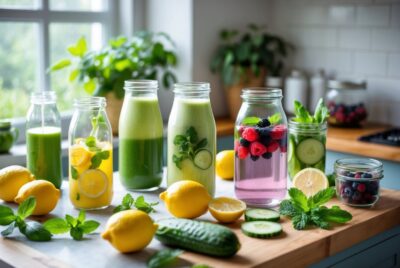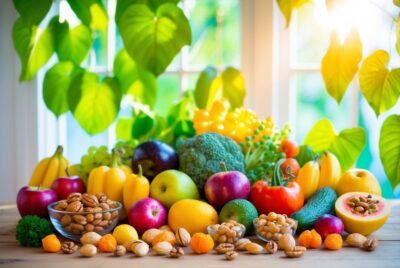What Is A Vegan Diet? The Basics And Benefits
*We may earn a commission for purchases made using our links. Please see our disclosure to learn more.
What is a Vegan Diet: Exploring Plant-Based Nutrition Fundamentals
A vegan diet is a plant-based eating pattern that I follow which eliminates all animal products, including dairy, eggs, honey, and meat. It’s grounded in ethical, environmental, and health considerations, with the fundamental idea of minimizing harm to animals and reducing ecological impact. It’s been gaining popularity due to its potential benefits, which include weight loss, improved heart health, and better blood sugar control.

As someone who adheres to a vegan lifestyle, I ensure my meals are rich in whole grains, vegetables, fruits, legumes, nuts, and seeds. This variety helps me avoid the common nutrient deficiencies that might arise from excluding animal products. Eating a balanced vegan diet can provide all the necessary nutrients, although attention must be paid to specific vitamins and minerals such as vitamin B12 and iron, which are more readily available from animal sources.
Additionally, by choosing a vegan diet, I aim to lower my carbon footprint as plant-based diets tend to require fewer resources like water and land and produce fewer greenhouse gases compared to diets that include meat. The ethical aspect of veganism—the commitment not to exploit animals—is equally important to me and it influences the choices I make in food, as well as other consumer goods. Veganism, for me, is a comprehensive lifestyle choice that reflects my values and commitment toward health, ethics, and the environment.
Understanding Veganism

In my exploration of veganism, I’ll address its core ideology, developmental history, and distinguishing characteristics from vegetarianism.
Definition and Principles
Veganism is a dietary and lifestyle choice characterized by the exclusion of all animal products. My understanding dictates that it’s not just about avoiding meat; it extends to dairy, eggs, and any other substances derived from animals. The principles of veganism are deeply rooted in ethics, with the primary goal of reducing animal exploitation and cruelty. The overarching philosophy is driven by the desire to live harmoniously without causing harm to other living creatures. Importantly, veganism also advocates for the utilization of animal-free alternatives in all aspects of life, not just food.
History and Evolution
Tracing the evolution of veganism, it’s clear that the term ‘vegan’ was first established in 1944, even though the concept existed long before. Initially, it was a way to describe vegetarians who did not consume dairy. Over time, veganism has grown into a full-fledged movement encompassing an ethical lifestyle choice. As knowledge about animal welfare and environmental concerns has increased, so has the adoption of veganism. People choose this lifestyle for various reasons, from ethical concerns to health motivations or environmental considerations.
Differentiating Vegan from Vegetarian
A common confusion lies in differentiating a vegan diet from a vegetarian one. Vegetarianism involves abstaining from eating meat, poultry, and sometimes fish. However, vegetarians might still consume dairy or eggs. In contrast, veganism takes a more comprehensive stance with a total avoidance of all animal-derived products. This means no meat, dairy, eggs, and often extends to excluding honey, gelatin, and other byproducts not present in a vegetarian diet. Veganism is often seen as an extension of vegetarianism, with a stricter adherence to principles that forbid all forms of animal exploitation.
Health and Nutrition
A vegan diet, while rich in fruits, vegetables, and other plant-based foods, requires careful planning to meet all nutritional needs. It’s essential for me to address specific nutritional considerations, manage nutrient intake properly, and understand the diet’s impact on chronic diseases.
Nutritional Considerations
As a plant-based dieter, I ensure an adequate intake of healthy fats, which can be found in foods like avocados, seeds, and nuts. Protein is equally crucial, and abundant in legumes, beans, and soy products. My fiber intake naturally soars with the consumption of whole grains, legumes, and vegetables, promoting digestive health.
Managing Nutrient Intake
I am mindful of nutrients that are commonly deficient in vegan diets:
- Iron: I choose iron-rich plant foods such as lentils, chickpeas, and fortified cereals and consume them with vitamin C-rich foods to enhance absorption.
- Calcium and Vitamin D: Since I avoid dairy, I focus on calcium-fortified plant milks and orange juice, as well as tofu and leafy greens. Adequate sunlight exposure and, if necessary, supplements help maintain my vitamin D levels.
- Vitamin B12: It’s essential for me, so I regularly consume fortified foods or a B12 supplement.
- Zinc and Iodine: Whole grains and legumes provide zinc; to maintain iodine levels, I include iodized salt or seaweed in my meals.
Vegan Diet and Chronic Diseases
Scientific studies suggest that a well-planned vegan diet may reduce the risk of:
- Heart Disease: High in fiber and low in cholesterol, this diet promotes heart health.
- Type 2 Diabetes: The emphasis on whole foods with low glycemic indices may aid in blood sugar control.
- Cancer: Certain cancers may be less prevalent thanks to the high intake of fruits and vegetables providing antioxidants and phytochemicals.
- Weight Loss: A vegan diet can lead to a calorie deficit without compromising on nutrient density, aiding in weight loss.
I avoid nutrient deficiencies through strategic dietary choices and supplementation where necessary.
Environmental and Ethical Considerations

In my exploration of a vegan diet, I focus on two critical areas: the environment and ethics. Both are intertwined with the choices that define veganism.
Impact on Environment
A vegan diet is often seen as more environmentally sustainable than diets including animal products. By avoiding meat, dairy products, fish, leather, and wool, my dietary and lifestyle choices can drastically reduce my carbon footprint and resource consumption. The environmental benefits I promote through following a vegan diet include:
- Lower greenhouse gas emissions: Livestock farming is a significant contributor to carbon and methane emissions, which I sidestep completely.
- Conservation of water resources: The production of animal-based foods typically consumes more water compared to plant-based options, so my vegan meals tend to lead to water conservation.
- Reduction in land use: A vegan diet helps in reducing the deforestation and land degradation that are often a consequence of animal farming.
I carefully select my diet to minimize harm to the environment, thus supporting biodiversity and ecosystem health.
Ethical Benefits
My vegan lifestyle is guided by a strong ethical framework that respects animal rights. Choosing not to consume or use any animal products, I take a stand against practices I view as cruel or inhumane. Here are key ethical benefits that come with a vegan diet:
- Preventing animal exploitation: I avoid products derived from animals, which means I do not support industries that I believe exploit animals for meat, dairy, eggs, or clothing.
- Promoting compassion: Through my vegan choices, I advocate for a more compassionate world where the welfare of all creatures is valued.
- Encouraging humane alternatives: I support the development and use of products that do not harm animals, such as plant-based leather alternatives.
By excluding animal products from my diet and lifestyle, I aim to embody a living example of ethical consumption.
What is a Vegan Diet: Plant-Based Food Sources

In a vegan diet, it is important to ensure you get all your necessary nutrients from plant-based sources. These foods are vital for maintaining health and can be just as satisfying as traditional meat-based options.
Proteins and Alternatives to Meat
When it comes to protein, my advice is quite clear: rely on legumes, such as beans, lentils, and peas, which are excellent sources. Tofu and tempeh are outstanding soy products that stand in for meat due to their high protein content and versatility in cooking. Quinoa, a complete protein grain, also serves as a staple in many vegan diets. Here’s a breakdown of protein-rich plant-based foods:
- Legumes: includes peas, beans, and lentils
- Nuts and Seeds: such as almonds, chia seeds, and flaxseeds
- Soy Products: tofu, tempeh, and edamame
- Whole Grains: examples include quinoa, brown rice, and barley
- Meat Substitutes: typically made from soy, peas, or wheat gluten
What is a Vegan Diet: Vitamins and Supplements
I ensure I get all the essential vitamins typically found in an omnivorous diet by incorporating certain fortified foods and sometimes supplements into my routine. Vitamin B12, crucial for nerve function, can be found in fortified plant milks and nutritional yeast. Vitamin D supplements might be necessary, especially if I have limited sun exposure. Omega-3 fatty acids can be sourced from algae supplements, flaxseeds, and chia seeds, which are perfect for maintaining heart health.
Diverse Vegan Ingredients
A truly varied vegan diet encompasses a colorful array of vegetables, fruits, leafy greens, sweet potatoes, and other whole foods. These provide not just essential vitamins and minerals, but also a plethora of flavors and textures to enjoy. Incorporating a rich variety of these foods ensures I get a balance of nutrients. For instance, leafy greens like spinach and kale are abundant in iron and calcium, while berries are rich in antioxidants. Here’s a snapshot of diverse plant-based ingredients:
- Vegetables: bell peppers, broccoli, and carrots
- Fruits: apples, berries, and citrus fruits
- Whole Foods: whole grains, legumes, nuts, and seeds
- Specialty Foods: nutritional yeast and plant milks like almond or soy
By focusing on these whole, unprocessed foods, I can maintain a nutritionally balanced and enjoyable vegan diet.
Implementing a Vegan Diet
When I transition to a vegan diet, I focus on eliminating animal products while ensuring nutritional adequacy and culinary variety. Meal planning becomes pivotal, while lifestyle adjustments help navigate the challenges ahead.
Getting Started with Veganism
When I first embrace veganism, I start by educating myself about plant-based nutrition and the importance of a well-rounded vegan diet. I create a shopping list featuring essentials like oats, brown rice, broccoli, spinach, chickpeas, soybeans, bananas, avocados, and berries. These items offer a balance of protein, carbohydrates, fats, vitamins, and minerals necessary for maintaining my health.
- Proteins: Chickpeas, soybeans, lentils
- Fats: Avocado, nuts, seeds
- Carbohydrates: Brown rice, oats, sweet potatoes
- Vitamins & Minerals: Spinach, kale, broccoli, berries
What is a Vegan Diet: Meal Planning and Recipes
My weekly meal planning involves a combination of recipes that cater to my nutritional needs and personal tastes. I prioritize whole foods over processed options and often prepare homemade yogurt from coconut or soy. I also discover that simple recipes, such as a spinach salad with chickpeas, or a banana and peanut butter smoothie, provide me with substantial nutrition and energy.
- Breakfast: Oatmeal with berries and flaxseeds
- Lunch: Quinoa salad with mixed greens and roasted chickpeas
- Dinner: Stir-fried tofu with broccoli and a side of brown rice
Lifestyle Changes and Challenges
Adopting a vegan lifestyle extends beyond diet to encompass various aspects of life, including clothing and personal care products. The transition sometimes brings challenges, such as eating out or finding alternatives to ingredients like sugar and certain oils. However, by preparing in advance, such as researching restaurants with vegan options or carrying nutritious snacks like almonds and a piece of apple, I make the lifestyle sustainable. Understanding the impact of my food choices on my body mass index and heart health helps me overcome these challenges. Also, I note improvements in managing conditions like arthritis due to the anti-inflammatory nature of many plant-based foods.
Frequently Asked Questions
In this section, I address some of the most common inquiries about the vegan diet, explaining the essentials and offering guidance to newcomers.
1. What are the main differences between a vegan and a vegetarian diet?
The primary distinction lies in the absolute exclusion of all animal products in a vegan diet, which includes dairy, eggs, and honey, whereas a vegetarian diet might include one or more of these items.
2. What foods are included in a basic vegan diet food list?
A basic vegan diet encompasses fruits, vegetables, legumes, nuts, seeds, and whole grains. These foods form the backbone of a vegan diet, providing a wide range of nutrients.
3. How can someone start a vegan diet as a beginner?
As a beginner, one can start by gradually phasing out animal products and experimenting with plant-based substitutes. It’s also helpful to learn new vegan recipes and to plan meals ahead.
4. What are common vegan substitutes for animal-based products?
Common vegan substitutes include almond, oat, or soy milk for dairy milk; tofu or tempeh for meat; and flaxseeds or chia seeds mixed with water as an egg replacement.
5. Are there health benefits associated with following a vegan diet?
There are health benefits associated with a well-planned vegan diet, such as a reduced risk of heart disease, diabetes, and certain cancers, due largely to a diet rich in fruits, vegetables, and whole grains.




